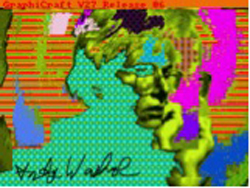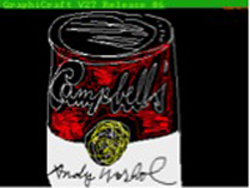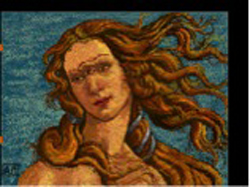Press Release: Previously Unknown Warhol Works Discovered on Floppy Disks from 1985
Carnegie Mellon, Artist and Museums Collaborate To Rescue Early Digital Art Through "Forensic Retrocomputing"
Contacts: Pam Wigley / 412-268-1047 / pwigley@andrew.cmu.edu
Byron Spice/ 412-268-9068 / bspice@cs.cmu.edu
Golan Levin / 917-520-7456 / golan@andrew.cmu.edu
 PITTSBURGH—A multi-institutional team of new-media artists, computer experts and museum professionals has discovered a dozen, previously unknown, artworks by Andy Warhol on aging floppy disks from 1985. Warhol earned a bachelor's degree in fine arts from Carnegie Mellon University, then Carnegie Institute of Technology, in 1949.
PITTSBURGH—A multi-institutional team of new-media artists, computer experts and museum professionals has discovered a dozen, previously unknown, artworks by Andy Warhol on aging floppy disks from 1985. Warhol earned a bachelor's degree in fine arts from Carnegie Mellon University, then Carnegie Institute of Technology, in 1949.
The purely digital images, "trapped" for nearly 30 years on Amiga® floppy disks stored in the archives collection of The Andy Warhol Museum (AWM), were discovered and extracted by members of the Carnegie Mellon University Computer Club, with assistance from the AWM's staff, CMU's Frank-Ratchye STUDIO for Creative Inquiry (FRSCI), the Hillman Photography Initiative at the Carnegie Museum of Art (CMOA) and New York-based artist Cory Arcangel.
 Warhol's Amiga experiments were the products of a commission by Commodore International to demonstrate the graphic arts capabilities of the Amiga 1000 personal computer. Created by Warhol on prototype Amiga hardware in his unmistakable visual style, the recovered images reveal an early exploration of the visual potential of software imaging tools, and show new ways in which the pre-eminent American artist of the 20th century was years ahead of his time.
Warhol's Amiga experiments were the products of a commission by Commodore International to demonstrate the graphic arts capabilities of the Amiga 1000 personal computer. Created by Warhol on prototype Amiga hardware in his unmistakable visual style, the recovered images reveal an early exploration of the visual potential of software imaging tools, and show new ways in which the pre-eminent American artist of the 20th century was years ahead of his time.
The impetus for the investigation came when Arcangel, a self-described "Warhol fanatic and lifelong computer nerd," learned about Warhol's Amiga experiments from a 1985 Commodore infomercial on YouTube. Acting on a hunch, and with the support of CMOA curator Tina Kukielski, Arcangel approached the AWM in December 2011 regarding the possibility of restoring the Amiga hardware in the museum's possession, and cataloging any files on its associated diskettes.
 In April 2012, Arcangel contacted Golan Levin, a CMU art professor and director of the FRSCI, a laboratory that supports "atypical, anti-disciplinary and inter-institutional" arts research. Offering a grant to support the investigation through the STUDIO's Frank-Ratchye Fund for Art @ the Frontier, Levin connected Arcangel with the CMU Computer Club, a student organization that had gained renown for its expertise in "retrocomputing," or the restoration of vintage computers.
In April 2012, Arcangel contacted Golan Levin, a CMU art professor and director of the FRSCI, a laboratory that supports "atypical, anti-disciplinary and inter-institutional" arts research. Offering a grant to support the investigation through the STUDIO's Frank-Ratchye Fund for Art @ the Frontier, Levin connected Arcangel with the CMU Computer Club, a student organization that had gained renown for its expertise in "retrocomputing," or the restoration of vintage computers.
CMU Computer Club members determined that even reading the data from the diskettes entailed significant risk to the contents, and would require unusual tools and methodologies. By February 2013, in collaboration with collections manager Amber Morgan and other AWM archivists, the club had completed a plan for handling the delicate disk media, and gathered at The Andy Warhol Museum to see if any data could be extracted. The Computer Club set up a cart of exotic gear, while a video crew from the Hillman Photography Initiative, under the direction of Kukielski, followed their progress.
It was not known in advance whether any of Warhol's imagery existed on the floppy disks — nearly all of which were system and application diskettes onto which, the team later discovered, Warhol had saved his own data. Reviewing the disks' directory listings, the team's initial excitement on seeing promising file names like "campbells.pic" and "marilyn1.pic" quickly turned to dismay, when it emerged that the files were stored in a completely unknown file format, unrecognized by any utility. Soon afterward, however, the club's forensics experts had reverse-engineered the unfamiliar format, unveiling 28 never-before-seen digital images that were judged to be in Warhol's style by the AWM's experts. At least 11 of these images featured Warhol's signature.
The images depict some of Warhol's best-known subjects — Campbell's® soup cans, Botticelli's Venus, and self-portrait, for example — articulated through uniquely digital processes such as pattern flood fills, palletized color and copy-paste collage. "What's amazing is that by looking at these images, we can see how quickly Warhol seemed to intuit the essence of what it meant to express oneself, in what then was a brand-new medium: the digital," Arcangel said.
The team's efforts are documented in the Hillman Photography Initiative's new short film, "Trapped: Andy Warhol's Amiga Experiments," which will premiere at 7 p.m., Saturday, May 10, at Carnegie Library Lecture Hall in Pittsburgh. The screening will be followed by a conversation with some of the team's key players, including artists Arcangel and Levin; Michael Dille, who just completed his Ph.D. in robotics at CMU, and Keith A. Bare of the CMU Computer Club; and outside guest Jon Ippolito, a professor of digital media curation at the University of Maine. The Trapped documentary will be available online at http://nowseethis.org on May 12.
A detailed report about the CMU Computer Club's retrocomputing work on the Warhol/Amiga image recovery project can be found here: http://studioforcreativeinquiry.org/public/warhol_amiga_report_v10.pdf
###
Support:
Financial support for the Warhol/Amiga data recovery project came from the Frank-Ratchye Fund for Art @ the Frontier, an endowment to encourage innovative arts research by the faculty, students and staff of Carnegie Mellon University.
The Carnegie Museum of Art and the Frank-Ratchye STUDIO for Creative Inquiry at Carnegie Mellon receive state arts funding support through grants from the Pennsylvania Council on the Arts, a state agency funded by the Commonwealth of Pennsylvania.
General operating support for the Carnegie Mellon Computer Club comes from the CMU Student Activities Fee and the CMU School of Computer Science. General operating support for the Carnegie Museum of Art is provided by The Heinz Endowments and Allegheny Regional Asset District. Support for the Carnegie Museum of Art's Hillman Photography Initiative was provided by the William T. Hillman Foundation and the Henry L. Hillman Foundation.
Images Approved for Publication:
Images are available from The Andy Warhol Museum pressroom at http://www.warhol.org/museum/pressroom/.
Persons or organizations seeking to reproduce the images accompanying this press release should contact both of the following persons for necessary permissions:
Greg Burchard / BurchardG@warhol.org / 412-237-8336
Senior Manager of Rights and Reproductions, The Andy Warhol Museum
Janet Hicks / jhicks@arsny.com / 212-420-9160
Director of Permissions, Artists Rights Society (ARS)
List of Images:

Andy2, 1985
Andy Warhol (American, 1928-1987)
Digital image, from disk 1998.3.2129.3.4
The Andy Warhol Museum, Pittsburgh;
Founding Collection, Contribution The Andy Warhol Foundation for the Visual Arts, Inc.
(c) 2014 The Andy Warhol Foundation for the Visual Arts, Inc. / Artists Rights Society (ARS), New York

Campbells, 1985
Andy Warhol (American, 1928-1987)
Digital image, from disk 1998.3.2129.3.22
The Andy Warhol Museum, Pittsburgh;
Founding Collection, Contribution The Andy Warhol Foundation for the Visual Arts, Inc.
(c) 2014 The Andy Warhol Foundation for the Visual Arts, Inc. / Artists Rights Society (ARS), New York

Venus, 1985
Andy Warhol (American, 1928-1987)
Digital image, from disk 1998.3.2129.3.22
The Andy Warhol Museum, Pittsburgh;
Founding Collection, Contribution The Andy Warhol Foundation for the Visual Arts, Inc.
(c) 2014 The Andy Warhol Foundation for the Visual Arts, Inc. / Artists Rights Society (ARS), New York